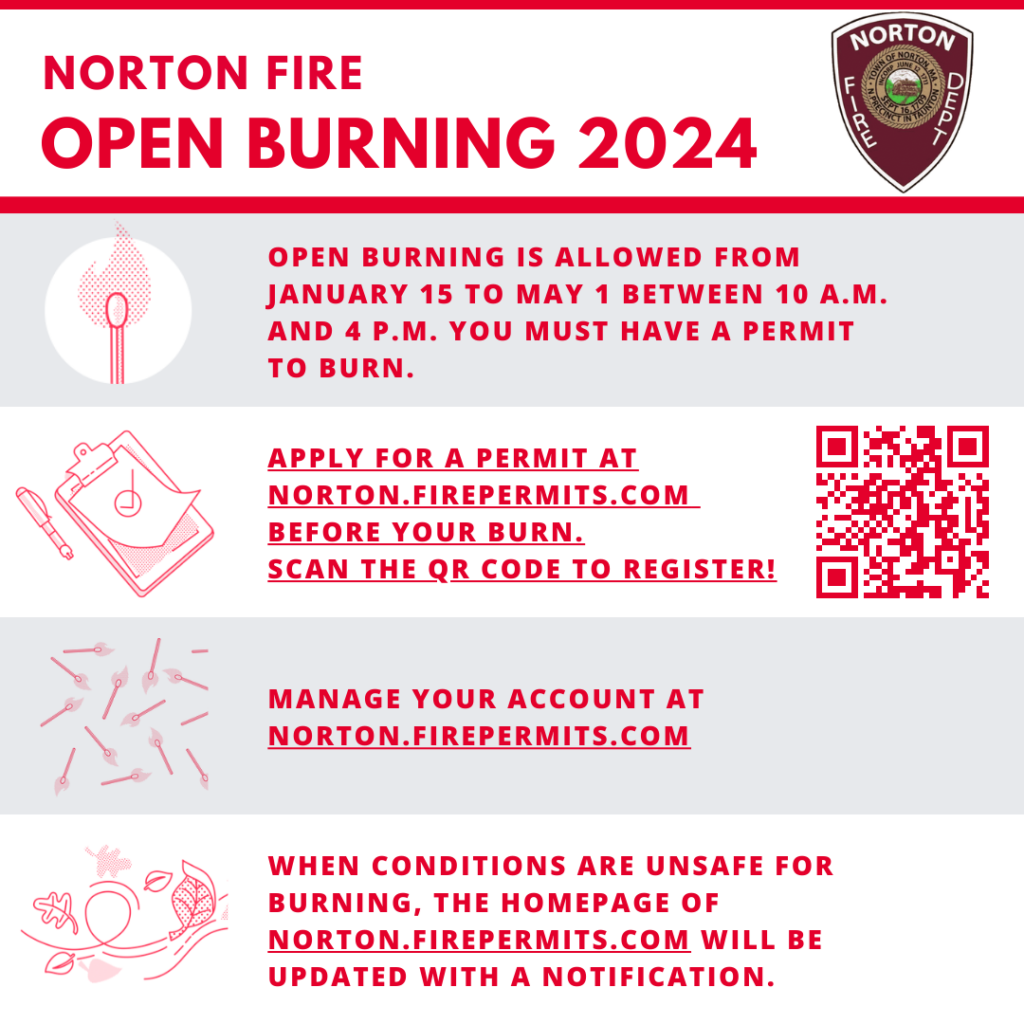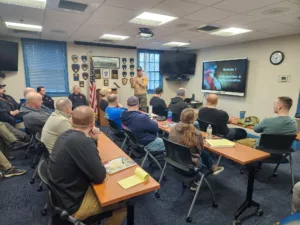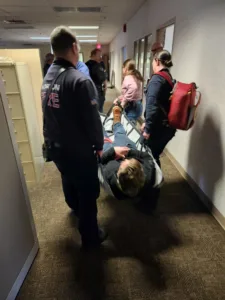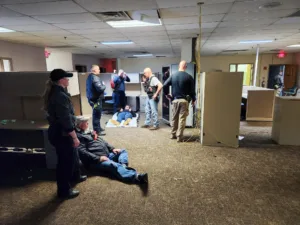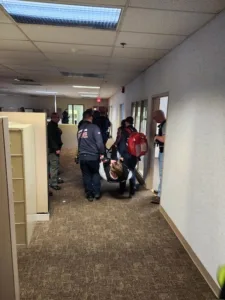The Norton Fire and Police Department participated in a 2 day training class on Active Shooters. A special Thanks to Lt Jason Brennan from Medway Police Department, and Whole Foods Warehouse for allowing this training to take place at their facility.
Norton Fire Department Receives Nearly $14,000 Grant for Firefighter Safety Equipment
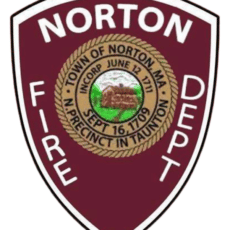
NORTON— Chief Shawn Simmons is pleased to report that the Norton Fire Department received a $13,917.98 grant from the Department of Fire Services Fiscal Year 2024 Firefighter Safety Equipment Grant Program.
The Norton Fire Department will use the funding to purchase structural firefighting gear.
Fire departments across Massachusetts were invited to apply to the Firefighter Safety Equipment Grant program, which provides reimbursement on purchases of 135 different types of eligible equipment. Eligible items include hoses and nozzles, turnout gear, ballistic protective equipment, gear washers and dryers, thermal imaging cameras, hand tools and extrication equipment, communications resources, hazardous gas meters, and more. In many cases, the purchase of this equipment will help departments attain compliance with Occupational Safety & Health Administration or National Fire Protection Association safety standards. This is the fourth year that funding has been awarded through the program.
“The Firefighter Safety Equipment Grants are an investment in the health and safety of Massachusetts firefighters,” said State Fire Marshal Jon Davine. “The flexibility of the program is especially valuable because it allows each department to make purchases based on their specific needs and resources. It has become a vital part of the way the Massachusetts fire service prepares for the constantly evolving threats in the world around us.”
###
Congratulations to Fire Chaplain Bernard Hinckley

The Norton Fire Department congratulates Rev. Bernard Hinckley on his 25th Anniversary of Ordination. Rev. Hinckley also serves as the Norton Fire Department Chaplain. Thank you Bernie for all you do for the Norton Fire Department and its members both past and present, we hope you are with as as Fire Chaplain for another 25 years!
Norton Fire Department Shares Burn Injury Prevention Tips During National Burn Awareness Week
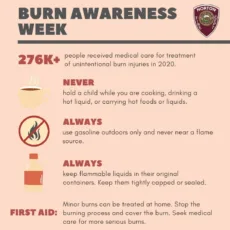
Chief Shawn Simmons and the Norton Fire Department would like to share safety tips with the community as a part of National Burn Awareness Week.
Burn Awareness Week, organized by the American Burn Association (ABA), began this year on Sunday, Feb. 4, and ends on Saturday, Feb. 10. This annual campaign serves as an opportunity for fire officials to share common burn prevention messages with their communities.
The 2024 Burn Awareness Week theme is flammable liquid burns.
According to the ABA, 276,086 people received medical care for treatment of unintentional burn injuries in 2020. The primary causes of injury include fire, scalds, and contact with hot objects, electricity and chemicals. Most of the injuries occur in the home.
Vapors from flammable and combustible liquids can ignite, causing a fire. There are many commonly used flammable liquids, including gasoline, lacquers, and nail polish. The following safety tips to prevent burns caused by flammable liquids are provided by the ABA and National Fire Protection Association:
Cooking Liquids
- Always wipe clean the stove, oven, and exhaust fan to prevent grease buildup.
- Wear short or close-fitting sleeves when cooking.
- Keep a pan lid and dry potholders or oven mitts near you EVERY time you cook.
- Turn pot or pan handles toward the back of the stove. When frying, use a pan lid or splash guard to prevent grease splatter.
- Allow food to rest before removing it from the microwave. When heating food in the microwave, use microwave-safe cookware that allows steam to escape.
- Never hold a child while you are cooking, drinking a hot liquid, or carrying hot foods or liquids.
Gasoline
- Use gasoline outdoors only, and store in cool, well-ventilated areas. Don’t store gasoline in the house.
- Start charcoal grills only with fluid labeled as “charcoal starter fluid.”
- Keep gasoline in a secure location, out of the reach of children.
- Use containers that have been listed, labeled, or approved for gasoline
- Fill equipment with gas when engines are cool
- Don’t use gasoline near a flame source such as burning leaves or brush
- Don’t use gasoline as a cleaning fluid or solvent
- Don’t dispense gasoline into a portable container while it is located inside the vehicle or pickup truck bed
Other Flammable/Combustible Liquids
- Never leave rags used to clean paint or stain in a pile. At the end of the day, take the rags outside to dry. Keep them away from buildings. Put dried rags in a metal container with a water and detergent solution to break down the oils and ensure the cover is tight.
- Keep containers of oily rags in a cool place, out of direct sunlight and away from other heat sources.
- Flammable and combustible liquids should not be used near an open flame. Do not smoke when working with these liquids.
- Keep flammable liquids in their original containers. Keep them tightly capped or sealed. Never store the liquids in glass containers.
Burn Injuries
Minor burns can be treated at home. According to the ABA, initial first aid treatment includes:
- Stop the burning process: cool a burn by running cool (not cold) water for at least 5 minutes.
- Remove all jewelry, watches, rings, and clothing around the burned area as soon as possible.
- Administer an over-the-counter pain reliever such as ibuprofen or acetaminophen for pain control. Follow the directions on the label. Consult a physician or health care provider if pain is not relieved.
- Cover the burn with a sterile gauze bandage or clean cloth. Wrap the burned area loosely to avoid putting too much pressure on the burned tissue.
- For a small area burn (less than 1% or the size of the person’s hand), apply soothing lotions that contain aloe vera to a burned area to help relieve the pain and discomfort.
Minor burns will usually heal without further treatment. If you have a significant burn injury it is important to seek treatment at a burn center. Several factors – like location and size – are important when treating burns. If you are unsure on the seriousness of an injury, review the ABA’s guidance on When to Seek Medical Care.
For more information on National Burn Awareness Week and flammable liquid burn injuries, visit the ABA website.
###
NEMA Deputy Director Ray Cord Receives Humanitarian Award
The Norton Fire Department would like to Congratulate NEMA Deputy Director Ray Cord for receiving the first annual Humanitarian Award. This award could not go to a more deserving person. We thank Ray for all he does for our Community.
St. Mary’s Church Service for Departed Norton Fire Department Members

St. Mary’s Church will be naming departed members of the Norton Fire Department at their services on 2/18/24 at 0800. St. Mary’s is also inviting any family members of a departed Norton Firefighter to a pancake breakfast immediately following the services. Please call St. Marys at 508-285-4241 if you are attending the breakfast.
Norton Fire Department asks Everyone to Check your Sump Pumps
Possible Rain and Wind Impacts Tuesday Evening Through Wednesday Afternoon
Possible Rain and Wind Impacts Tuesday Evening Through Wednesday Afternoon
Residents can expect very heavy rainfall and high winds this evening through tomorrow afternoon (January 9-10).
Wind gusts of 45-55 mph are expected and could cause downed trees and power lines as well as power outages. Rainfall of approximately 2-3 inches is also expected. Some flooding of rivers, creeks, streams, and other low-lying and flood-prone locations is possible given the combination of heavy rainfall and snow melt.
Power Outages: Should you experience a power outage, report it directly to National Grid. Please do not call 911 to report an outage or to ask about power restoration as it ties up emergency lines and dispatchers. Additional safety information regarding power outages can be found here.
Generator Safety: During power outages, those using a generator are reminded to use extreme caution and allow for proper ventilation. Never use a generator indoors or inside a garage. Keep generators away from doors, windows and HVAC air intakes, and point the exhaust away from the building. Be sure that you have working carbon monoxide detectors. When using generators, it is also extremely important to use a proper transfer/disconnect switch, otherwise, you risk harming electrical line workers making repairs. Additional safety information regarding the use of generators can be found here.
Downed Power Lines: Remember to stay away from all downed power lines and never go near or touch them. Treat all down wires as live electrical wires. Do not get close to them as electrocutions can occur without direct contact. Please do not drive around or move barriers placed by public safety members.
Please be a good neighbor and check on family, friends and neighbors, especially the elderly, those who live alone, and those who may need additional assistance. Always call 911 in an emergency.
Safety Tips For Expected Weekend Winter Weather
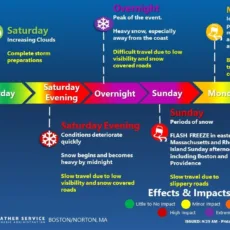
With some of the first snow accumulation of the season expected this weekend, residents are reminded of winter weather safety precautions.
Stay Informed:
While snow totals may continue to change, much of Massachusetts, Rhode Island and Connecticut can expect 6-12 inches with lower totals for cities and towns closer to the coast.
Visit weather.gov to see the most recent forecast as the storm approaches. Residents are reminded that the forecast can change quickly and at any point. Stay informed by following local alerts, warnings and public safety information before, during and after emergencies. Residents can also listen to local area radio, NOAA Radio or TV stations for the latest information and updates.
Prepare Your Vehicle:
- Check your tires’ tread.
- Make sure all fluid levels are full and ensure that the lights, heater and windshield wipers are in proper working condition. Keep the gas tank full to avoid ice in the tank and fuel lines.
- Don’t leave the house without a fully charged cellphone and car charger. Prepare a winter emergency kit to keep in your car in case you become stranded.
- Know whether your vehicle has an antilock brake system and learn how to use it properly.
If You Must Travel:
- Be aware of current and forecast weather conditions. Avoid non-essential travel when the National Weather Service has issued advisories.
- If you must travel, inform a friend or relative of your proposed route and expected time of arrival.
- Drive cautiously and increase your following distance enough so that you’ll have plenty of time to stop for vehicles ahead of you.
- Don’t crowd a snow plow or travel beside the truck. Snow plows travel slowly, make wide turns, stop often, overlap lanes, and exit the road frequently. If you find yourself behind a snow plow, stay far enough behind it and use caution if you pass the plow.
- Remain cautious even after conditions have improved. Even if roadways have been cleared of snow following a storm, any water left on the roadways may freeze, resulting in a clear sheet of ice, also known as black ice. Black ice is patchy ice on roadways that cannot easily be seen.
Take Precautions Outdoors:
- Wear appropriate outdoor clothing: wear a tightly woven, preferably wind-resistant coat or jacket; inner layers of light, warm clothing; mittens; hats; scarves; and waterproof boots.
- Cold weather puts an extra strain on the heart. If you have heart disease or high blood pressure, follow your doctor’s advice about shoveling snow or performing other hard work in the cold. Use caution and take frequent breaks.
- Sprinkle cat litter or sand on icy patches.
If you experience a power outage and plan to use a generator, use extreme caution and allow for proper ventilation. Never use a generator indoors or inside a garage. Keep generators away from doors, windows and HVAC air intakes. Be sure that you have working carbon monoxide detectors. Additional safety information regarding the use of generators can be found here.
Residents are also asked to assist firefighters by clearing snow away from fire hydrants during and after significant snowfall. Shovel a path from the hydrant to the street, and clear snow 3-5 feet all around the hydrant so firefighters have enough room to connect a hose.
For more winter weather safety tips or winter driving tips, visit the Centers for Disease Control and Prevention and the National Highway Traffic Safety Administration.
###
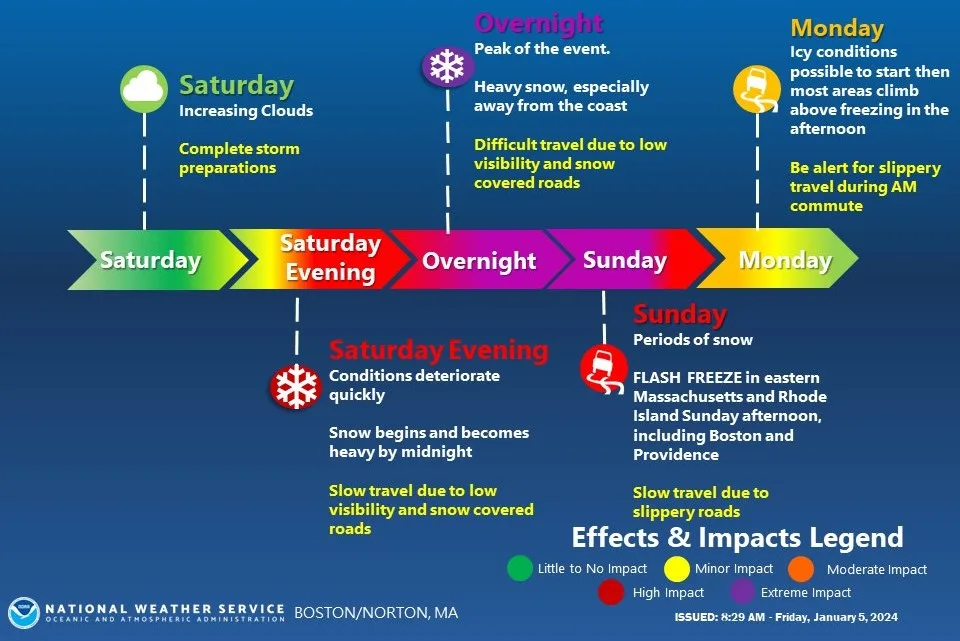
Norton Fire Department Announces Information on 2024 Open Burning Season
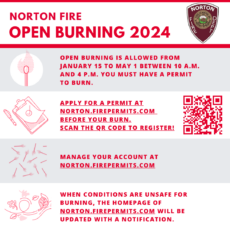
NORTON — Chief Shawn Simmons and the Norton Fire Department would like to remind Norton residents that open burning season begins Jan. 15 and runs through May 1. A permit is required to open burn in compliance with Massachusetts law.
Permits:
Residents can begin applying for a burn permit today by creating an account via the department’s new burn permit portal: norton.firepermits.com. Once you are registered, you can apply for your burn permit online by clicking “Get a Permit”. Residents will receive an email notifying them the permit is approved.
Once registered, residents can sign up to burn between the hours of 9:30 a.m. and 1 p.m.
If conditions are unsafe for burning, such as high winds or drought, a notification will be posted on the homepage.
Individuals who don’t have access to a computer should call the Norton Fire Department at 508-285-0248 for assistance with their burn permit application.
Open Burning:
Burning must be done:
- Between 10 a.m. and 4 p.m., from Jan. 15 to May 1
- At least 75 feet from all buildings
- As close as possible to the source of material being burned
Residents are allowed to burn:
- Brush, cane, driftwood and forestry debris (but not from commercial or industrial land clearing)
- Agricultural materials including fruit tree and bush prunings, raspberry stalks, and infected bee hives for disease control
- Trees and brush from agricultural land clearing
- Fungus-infected elm wood, if no other acceptable means of disposal is available
Residents may not burn:
- Leaves
- Brush, trees, cane or driftwood from commercial or industrial land clearing
- Grass, hay, leaves, stumps or tires
- Construction materials or demolition debris
- Household trash
What times are best for open burning?
- You can help prevent wildland fires by burning early in the season. Wet and snowy winter conditions help hinder the rapid spread of fire on or under the ground.
- Changing weather conditions and increased fire danger in spring can lead to many days when open burning is not allowed.
- April is usually the worst month for brush fires. When snow recedes, but before new growth emerges, last year’s dead grass, leaves and wood are dangerous tinder. Winds also tend to be strong and unpredictable in April.
For more information on open burning in Massachusetts, visit Mass.gov.
###
